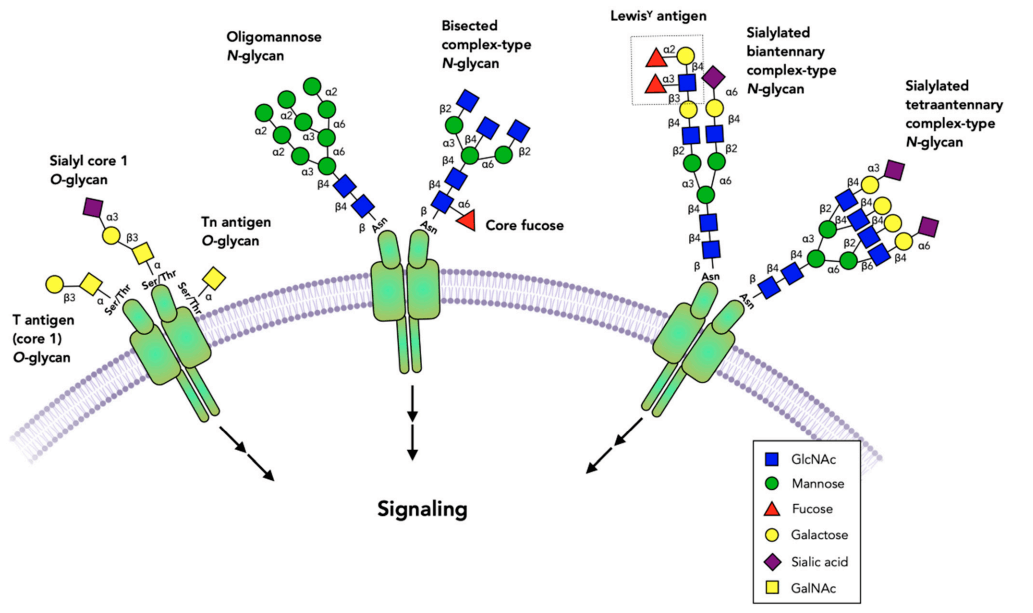Glycan in Acquired Human Disease
Many noninherited diseases are caused or influenced by acquired changes in glycan synthesis or recognition in humans. Thus, it is important to develop a useful detection strategy to improve diagnosis or therapies for glycan-related acquired human diseases. Creative Biolabs is a pioneer company in vitro diagnostic (IVD) market. With our professional scientists committed to research, we offer a full range of anti-glycans antibody development services for the diagnosis of all kinds of diseases. Our experienced scientists will take part in every step of your program to accelerate your project development.
Introduction
Glycans are one of the four basic components of cells, existing as covalent linkages of saccharides often attached to proteins and lipids, glycans consist of a large amount of the mass and structural variation in biological systems. Glycans can be degraded by endocytosis and trafficking to lysosomes. Defects in these catabolic steps include glycosidase deficiencies that can lead to the bases for cellular storage disorders such as Gaucher’s, Niemann-Pick type C, Sandhoff’s, and Tay-Sachs diseases. Besides, defects in the anabolic process of glycan formation are more typically considered as human diseases of glycosylation. I cell disease was the first to be found that attributes to failing to produce the mannose 6-phosphate modification on N-glycans in the Golgi. Currently, an increasing number of diseases of glycosylation are being identified, especially in the pediatric clinic among children during the first few years of life. Such as the inherited deficiencies in the conserved oligomeric Golgi (COG) complex members COG1 and COG7 in humans can cause a severe childhood disease and perinatal death, respectively. Thus, glycans play an important role in the molecular and cellular mechanisms that control health and disease.
To date, some engineering new chemical modifications into glycans of living cells may promote the ability to detect glycan function and contribute to future diagnosis and treatment of disease. Indeed, glycosylation defects in mice and humans related to diseases have been shown that the mammalian glycome contains a significant amount of biological information.
 Fig.1 Glycans commonly found on cell surface receptors.1, 2
Fig.1 Glycans commonly found on cell surface receptors.1, 2
Glycans in Acquired Human Diseases
Cardiovascular disorders such as heart attacks, strokes, and other serious diseases related to high levels of low-density lipoprotein (LDL) cholesterol and decreased high-density lipoprotein (HDL) cholesterol. The earliest phase of the development of atherosclerotic lesions (the fatty streak) attributes to the entry of monocytes into the subendothelial regions of the blood vessels. This process is associated with the expression of P- and/or E-selectin on the endothelium, which recognizes correctly glycosylated and sulfated P-selectin glycoprotein ligand-1 (PSGL-1) or sialyl Lewis x on circulating monocytes.
The oral cavity exists in the abundant host and microbial glycans. Certain viridans group streptococci that have serine-rich bacterial proteins whose stability requires O-glycosylation can result in dental caries and gingivitis. They also have a binding region that can recognize O-linked sialoglycans or oral mucins to allow attachment to cells in the mucosa. Upon these bacteria reach the bloodstream during dental procedures, the same binding proteins bind to platelet glycoproteins, thereby delivering the bacteria to damaged heart valves, and causing the serious disease of bacterial endocarditis.
A general feature of dermatitis is the entry of leukocytes into the dermis, where they recruit other types of cells that mediate tissue damage. Sometimes this leads to the chronic expression of E-selectin on endothelial cells. Some T helper 1 (Th1) lymphocytes enter the skin by expression of the PSGL-1 ligand for P-selectin.
Diabetes mellitus can lead to chronic vascular complications. One of the causes is the high glucose increases nonenzymatic glycation, wherein the open-chain (aldehyde) form of the glucose interacts with lysine residues on various proteins. Irreversible Amadori rearrangement then gradually produces adducts resulting in the “browning” (Maillard) reactions, which eventually progress to advanced glycation end products (AGEs). The resulting protein cross-links can damage cellular functions.
A variety of gastrointestinal pathogens react with the gut mucosa via the recognition of glycan structures. One example is cholera toxin, which binds GM1 ganglioside, and Helicobacter pylori, the cause of peptic ulcers and gastritis, which binds Lewis type glycans in the stomach mucosa.
Glycans are also involved in other diseases include hematology, immunology and rheumatology, Infectious diseases (IDs), nephrology, neurology and psychiatry, oncology: altered glycosylation in cancer and pulmonary medicine.
Features of Our Services
- Well-developed technology
- Dedicated platforms
- High specificity and stability
- High-affinity and high success rate
As an expert service provider, Creative Biolabs is also professional in tailoring antibody production. With the help of our glycans preparation as antigens for antibody discovery service, which can be utilized for immunization and antibody selection. With our Ph.D. level science team and years of experience, plenty of immunogens have been successfully obtained. We are more than happy to facilitate your projects and push the progress towards pre-clinical trials. Please feel free to contact us for more details.
References:
- Gao, Yin, et al. "Role of glycans on key cell surface receptors that regulate cell proliferation and cell death." Cells 10.5 (2021): 1252.
- Distributed under Open Access license CC BY 4.0, without modification.
- Cardiovascular Medicine related Glycan Introduction
- Dental Disease related Glycan Introduction
- Dermatology related Glycan Introduction
- Glycan in Endocrinology & Metabolism
- Glycan in Gastroenterology
- Hematology related Glycan Introduction
- Glycan in Immunology & Rheumatology
- Infectious Disease related Glycan Introduction
- Glycan in Nephrology
- Glycan in Neurology & Psychiatry
- Oncology related Glycan Introduction
- Glycan in Pulmonary Medicine
